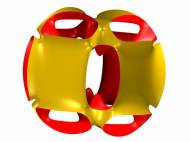Using algebraic equations to enhance robot motion
 Although robots advance each day, they still lack the fluent movement and gracefulness we’d expect them to have. A group of researchers from the University of Innsbruck employs new mathematical approaches to improve the control of robot movements. Aside making robots more graceful and efficient, the research might lead to better motion safety for both the robot and its surroundings.
Although robots advance each day, they still lack the fluent movement and gracefulness we’d expect them to have. A group of researchers from the University of Innsbruck employs new mathematical approaches to improve the control of robot movements. Aside making robots more graceful and efficient, the research might lead to better motion safety for both the robot and its surroundings.
In recent years, algebraic methods have in fact become increasingly popular in Mechanical Sciences, and the first theoretical results for their application in the area of robot motion are also available. Led by Prof. Manfred Husty and Prof. Hans-Peter Schröcker at the Faculty of Civil Engineering of the University of Innsbruck, the project of the Austrian Science Fund (FWF) is adapting the theory to the practical requirements of mechanical engineering.
“Safe means that a robot does not collide with its environment or with itself while performing its tasks. It also has to avoid what we call dangerous areas. This does not, however, involve physically present obstacles, but positions in the proximity of which the robot cannot be controlled due to geometric reasons, and thus may become dangerous. In robotics, we also call these areas singularity”, said Schröcker.
There are plenty of methods available for calculating such areas and for avoiding them when programming motion patterns. However, according to Schröcker, all of these methods are based on numeric calculations which aren’t accurate enough for applications in the real world. On the other hand, algebraic methods are more accurate, and they could also allow consideration of all dangerous areas in the calculations.
Instead solving continuous mathematical problems by means of discrete computer calculations, algebra uses variables, which allow more accurate and comprehensive calculations. Within the framework of this project, algebraic methods are being used in combination with numeric and geometric methods.
“The calculations can be thought of as connecting points in space by means of smooth curves which remain sufficiently far away from the areas that are to be avoided. Developing adequate methods for doing so is an essential objective of this FWF project that will combine fundamental mathematics and practical use”, said Schröcker.
Aside improving calculations, the development of new mathematical methods aims to increase efficiency by making the robot find the shortest route in a quick, elegant and energy-saving manner. Consideration of potential collisions and “dangerous” areas must also be considered when robot’s movement paths are calculated.









Leave your response!